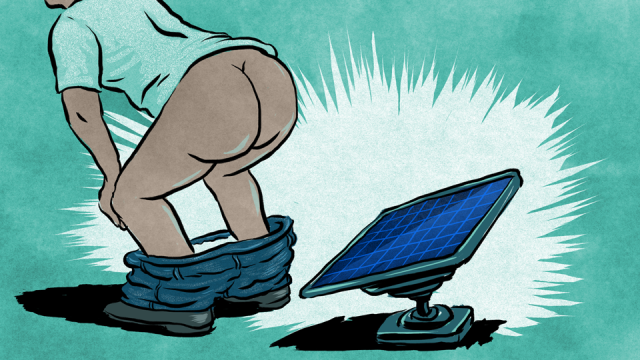Biometrics are everywhere. Fingerprint scanners are a standard feature in the newest smartphones, DNA testing is common, and facial recognition is getting more and more terrifyingly reliable. But there are many biometric applications still lurking on the fringe, and some of them get really, really personal.
These are the three most embarrassing ways biometrics can identify you now — and might identify you tomorrow.
Your Smell

We’ve got bad news: you smell. It doesn’t matter if you bathe three times a day and never break a sweat; everyone has a distinctive odor. Your signature scent is partly the product of a group of genes related to your immune system, called the major histocompatibility complex (MHC). The MHC helps determine what combination of chemicals your body secretes in sweat and urine, and those chemicals contribute to your own personal scent. Diet and environment play a role in how you smell, of course, but the genetic component is unique to each individual.
It’s subtle, especially to human noses. You can’t stick your nose in people’s armpits and tell them apart by body odor alone. On the other hand, there is some evidence that we do recognise the scent of people whose MHC genetics are likely to be very different from our own, and that that information subconsciously influences how we choose mates. That’s not a conscious process, however, and it’s definitely not the same thing as being able to distinguish one person from another by scent.
So, there must be a high-tech machine that can scan your body odor and print out your Social Security number, right? Nope. Scientists still haven’t worked out how to measure those very tiny differences, but dogs have the whole thing covered. They can even sniff out the difference between identical twins. Currently, dogs are the biotech devices — also known as “furry friends” — who do our scent identification for us.
Trailing dogs use this ability to help find missing people or criminal suspects. If the dogs can get a whiff of something that has the missing person’s scent on it, like a hat or a favourite shirt, they will recognise that scent when they find the trail. This is how trailing dogs know which scent trail to follow, so they don’t end up trailing police or bystanders instead of the person who’s actually missing.
The Microbes in Your Poop

Picture: NIAID via Wikimedia Commons
So you smell – but that’s no big deal, especially compared to the fact that you’ve actually got so many germs in your body that they outnumber your cells. About 2 per cent of your body mass is actually made up of bacteria, fungi, and other microbes that naturally call the human body home (feel free to use that figure the next time you don’t like what the bathroom scale says).
Your bacteria alone have your cells outnumbered by a factor of 10, but don’t worry – they’re mostly benevolent. Humans and certain microbe species have a symbiotic relationship; we provide them with homes and nourishment, and they help our bodies fight off more harmful invaders. It’s the product of millions of years of co-evolution. Plus, you’ll never be completely alone.
Scientists call the ecosystem of microbes living in your body your microbiome, and it turns out that everyone’s microbiome is a little different. Earlier this year, researchers discovered that the bacteria in your digestive tract leave a clear genetic signature in your faeces, which doesn’t change much over time. Using that signature, researchers were able to correctly match volunteers to their stool samples about 86 per cent of the time.
The poop biometric method isn’t reliable enough to hold up in court yet, depriving us all of some delightfully awkward court transcripts. But it could mean that stool samples in anonymous studies might actually be traced back to the patients who deposited them — a potential privacy concern.
Your Butt

Image Credit: Leszek Żmijewski via Wikimedia Commons
In case you don’t leave any poop behind as identification, a team of engineers in Japan is working on a device that can recognise your butt.
A few years ago, a mechanical engineer named Shigeomi Koshimizu, along with his team at the Advanced Institute of Industrial Technology in Tokyo, designed a biometric cover for car seats. With 360 embedded sensors, the sheet of fabric creates an individual profile of each driver’s butt, based on size, shape, weight distribution and pressure points. The idea is that the profile would be stored in the car’s computer system, and only drivers with registered butts would be able to start the car.
And it turns out that butt recognition is pretty accurate. The sensor sheets recognised drivers correctly about 98 per cent of the time in lab tests. Koshimizu had also considered using facial recognition or palm scanners on the steering wheel to identify drivers, but found those methods “overbearing,” according to the Wall Street Journal.
It’s probably going to be a while before your car will recognise you just by copping a feel, though. Koshimizu and his team demonstrated the scanners in 2012 and said that it would be a few years before they’d be ready for a commercial product. They haven’t made any announcement since then, it seems – but they could be sitting on the news.
Illustration: Jim Cooke
